The year is 1931, and you and some trusted colleagues have stumbled upon an archeological find that will change your careers forever, assuming you return to tell of your findings. During a scientific expedition to Antarctica, you have spotted what seem to be the remains of a city of epic proportions in the middle of a chain of seemingly impassable mountains. The architecture seems to be alien in its design. The only questions are: will your shoddy old prop plane be able to make the journey, who built this city, and what will be left of your sanity when you get there?
 Mountains of Madness is a new cooperative game by Rob Daviau, featuring gorgeous art from Miguel Coimbra, and published by Iello. It’s based on At The Mountains of Madness, a novella by H.P. Lovecraft. Players take on the role of the characters from the story as they work together to make their way from the coast, through the mountains, all the way up to the city at the top.
Mountains of Madness is a new cooperative game by Rob Daviau, featuring gorgeous art from Miguel Coimbra, and published by Iello. It’s based on At The Mountains of Madness, a novella by H.P. Lovecraft. Players take on the role of the characters from the story as they work together to make their way from the coast, through the mountains, all the way up to the city at the top.
The board forms a rough pyramid covered with Encounter tiles, with several Coast spaces on the bottom, Mountain spaces in the middle, and City spaces near the top. If the team is able to navigate their way up, the very peak of the mountain is a space called the Edge of Madness and there are three Escape spaces you’ll need to traverse if you hope to ever return home one day.
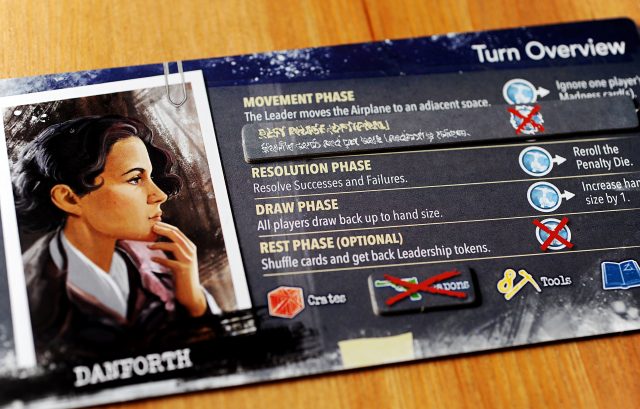 The progress of the expedition is marked by a small plane pawn. Each turn, the responsibilities of the team leader rotate along with the Sled board and Leadership tokens. The leader is in charge of figuring out where to go next, but they must always choose an adjacent space. It’s possible to make a beeline straight up the mountain, but that’s not really the best plan. You have to be prepared for what you’re going to meet at the top, and that can take a little more research.
The progress of the expedition is marked by a small plane pawn. Each turn, the responsibilities of the team leader rotate along with the Sled board and Leadership tokens. The leader is in charge of figuring out where to go next, but they must always choose an adjacent space. It’s possible to make a beeline straight up the mountain, but that’s not really the best plan. You have to be prepared for what you’re going to meet at the top, and that can take a little more research.
Being a scientific mission, all the team members will start with Equipment cards. The Equipment comes in four different suits; Crates, Tools, Weapons, and Books. The value of the cards range between 2-6, and each one has an image and description of an item that may be valuable on such a trip, like binoculars, tents, or revolvers. While the pictures add flavour, it’s the suit and value that you’ll really have to consider with each Equipment card. In the discard pile for the Equipment card will be as many Injury cards as there are players. They’ll eventually get shuffled into the deck and gum up players’ hands.
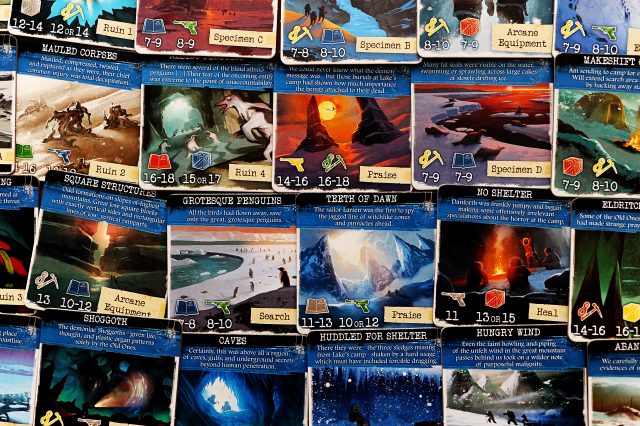 Each round starts with the Movement phase when the Leader decides where to go next on the mission. Once the Leader has determined the destination for the round, the Encounter phase begins, and the tile on the space is is flipped as well as the 30 second sand timer. The Encounter tiles each represent some occurrence on the terrifying mountains, such as coming a group of albino penguins, or hearing strange voices surrounding the party, or even finding some mauled corpses. Besides the name of the tile and some flavour text, the Encounter tile will also show Challenges that the team will have to overcome, in the form of meeting specific goals with their Equipment cards. Challenges might give a target that must be hit directly, such as 10 Books, or might give a range like 14-16 Crates. There are always at least two Challenges for players to overcome, but sometimes they’ll need to face three.
Each round starts with the Movement phase when the Leader decides where to go next on the mission. Once the Leader has determined the destination for the round, the Encounter phase begins, and the tile on the space is is flipped as well as the 30 second sand timer. The Encounter tiles each represent some occurrence on the terrifying mountains, such as coming a group of albino penguins, or hearing strange voices surrounding the party, or even finding some mauled corpses. Besides the name of the tile and some flavour text, the Encounter tile will also show Challenges that the team will have to overcome, in the form of meeting specific goals with their Equipment cards. Challenges might give a target that must be hit directly, such as 10 Books, or might give a range like 14-16 Crates. There are always at least two Challenges for players to overcome, but sometimes they’ll need to face three.
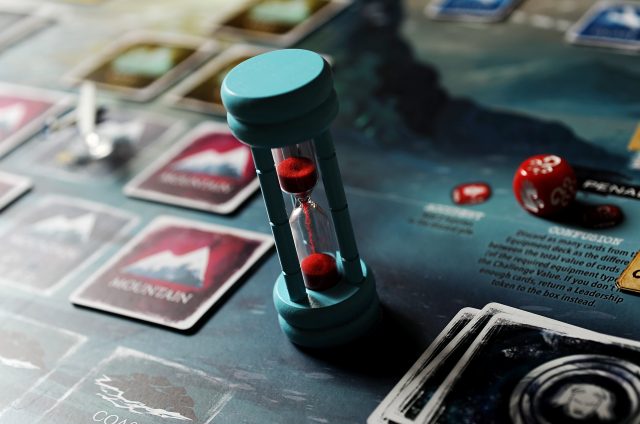 Once the Encounter tile and sand timer are flipped, players can openly discuss what they have in their hand, and it’s the job of the Leader to keep track of what Equipment each team member can contribute. As soon as the Leader takes cards from anyone and places them on the Sled board, discussion must end. Hopefully the team has communicated well enough to complete the Challenges of the Encounter.
Once the Encounter tile and sand timer are flipped, players can openly discuss what they have in their hand, and it’s the job of the Leader to keep track of what Equipment each team member can contribute. As soon as the Leader takes cards from anyone and places them on the Sled board, discussion must end. Hopefully the team has communicated well enough to complete the Challenges of the Encounter.
As long as you have passed at least one of the Challenges you’ll get a reward listed on the Encounter tile. However, if you fail any of the parts of the Encounter, you’ll be punished. A Reward can mean discovering 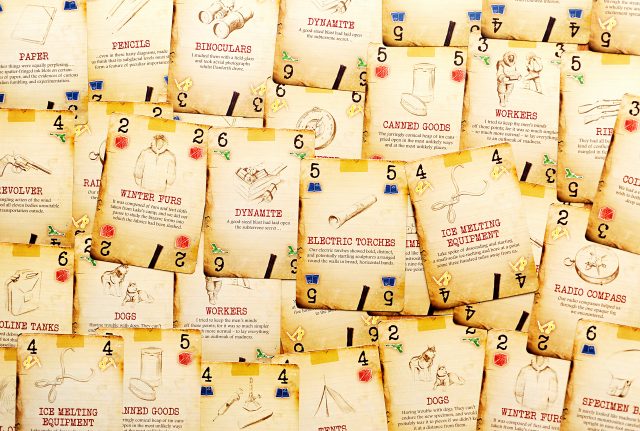 Relics, which take the form of Specimens, Ruins, or Knowledge. Getting as much information as you can about the Relics is important, because it will affect your end game score, but each time a player takes a Relic card, they must also take a Madness card (more on those later) and a token which covers up an ability on their personal board. Rewards can also allow players to Heal an Injury card out of the discard pile, earn Praise, allowing them to take Leadership tokens back, Search an adjacent tile, giving some advance knowledge of the terrain, or earn Arcane Equipment cards. These powerful cards represent alien technology and have a value of 10 in one of the four suits. They get added to the Equipment discard pile.
Relics, which take the form of Specimens, Ruins, or Knowledge. Getting as much information as you can about the Relics is important, because it will affect your end game score, but each time a player takes a Relic card, they must also take a Madness card (more on those later) and a token which covers up an ability on their personal board. Rewards can also allow players to Heal an Injury card out of the discard pile, earn Praise, allowing them to take Leadership tokens back, Search an adjacent tile, giving some advance knowledge of the terrain, or earn Arcane Equipment cards. These powerful cards represent alien technology and have a value of 10 in one of the four suits. They get added to the Equipment discard pile.
Punishment for failing some portion of an encounter forces players to either roll the Penalty die. This can lead to injuries, confusion, or a loss of confidence. Or they have the option of assigning a Madness card to a player.
 Madness cards are where the game really gets interesting. They come in three different levels and they will affect how players work with the rest of the team. When players get a Madness card they read it to themselves and then apply the effects during Encounter phases. They can force players to give high fives at the start of each encounter, or stop using numbers when referring to their cards, or even speak in a foreign language. If a player has a level one Madness card they must take a level two card and so on. The madness they encounter stacks, so as the game progresses, it can make for some interesting Encounter phases.
Madness cards are where the game really gets interesting. They come in three different levels and they will affect how players work with the rest of the team. When players get a Madness card they read it to themselves and then apply the effects during Encounter phases. They can force players to give high fives at the start of each encounter, or stop using numbers when referring to their cards, or even speak in a foreign language. If a player has a level one Madness card they must take a level two card and so on. The madness they encounter stacks, so as the game progresses, it can make for some interesting Encounter phases.
Throughout the course of the game, Leadership tokens can be discarded to get certain advantages like adding 30 more seconds to an Encounter phase, re-rolling the Penalty die, or taking a rest which allows them to reshuffle Equipment cards and gain back Leadership tokens (although this forces them to permanently remove a token from the game). If the team ever runs out of Leadership tokens, the mission is lost and so is the game.
 As the team moves slowly up the mountain, they will become more and more mad from the experience. The prospect of escape will seem like a fantasy and players will struggle to remember a time before this scientific mission began. Aside from the Madness cards, the game will start to mess with you in unexpected ways (I’ll leave that as a mystery for you to discover).
As the team moves slowly up the mountain, they will become more and more mad from the experience. The prospect of escape will seem like a fantasy and players will struggle to remember a time before this scientific mission began. Aside from the Madness cards, the game will start to mess with you in unexpected ways (I’ll leave that as a mystery for you to discover).
If the team manages to escape from the mountain and return to society they will get a score based on their findings. They count up the number of Relic cards they’ve collected and subtract the number of Injury cards the gained on the mission. That number gives a result ranging from being laughed out of their cushy university jobs to becoming the toast of the scientific world based on their brilliant discoveries.
Mountains of Madness is a weird game, and that’s a really good thing. It’s a tough one to review, because a lot of what you experience is quite unique. It is challenging and fun and I think it will force a lot of gamers to get out of their comfort zone. As the madness sets in, it’s definitely more fun playing with people that 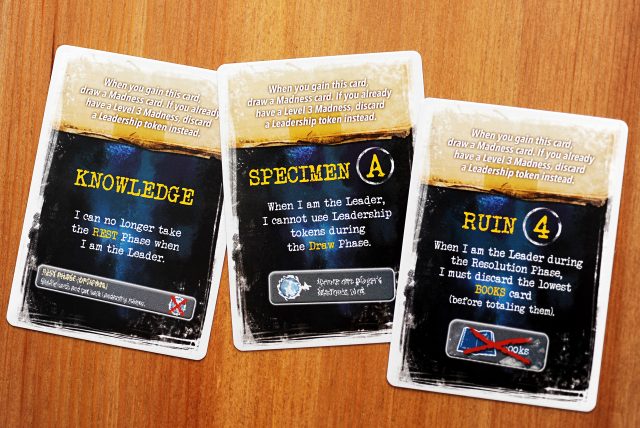 embrace the theatrical nature of the game. It’s like a strange mixture of performance, speedy decisions, and Lovecraftian intrigue. Daviau has done something tough to do in this day and age, he’s created something that feels really original. It’s not surprising, from the guy who innovated the Legacy mechanic, but it’s still really great to see new ideas come to the forefront.
embrace the theatrical nature of the game. It’s like a strange mixture of performance, speedy decisions, and Lovecraftian intrigue. Daviau has done something tough to do in this day and age, he’s created something that feels really original. It’s not surprising, from the guy who innovated the Legacy mechanic, but it’s still really great to see new ideas come to the forefront.
Even if you shy away from co-ops or games that force a little performance, I really recommend trying Mountains of Madness. I can say you’ve never experienced anything quite like it before, and hey, that’s worth risking your sanity over.
–
A media copy of Mountains of Madness was provided by Iello for this review.
Comments
No comments yet! Be the first!